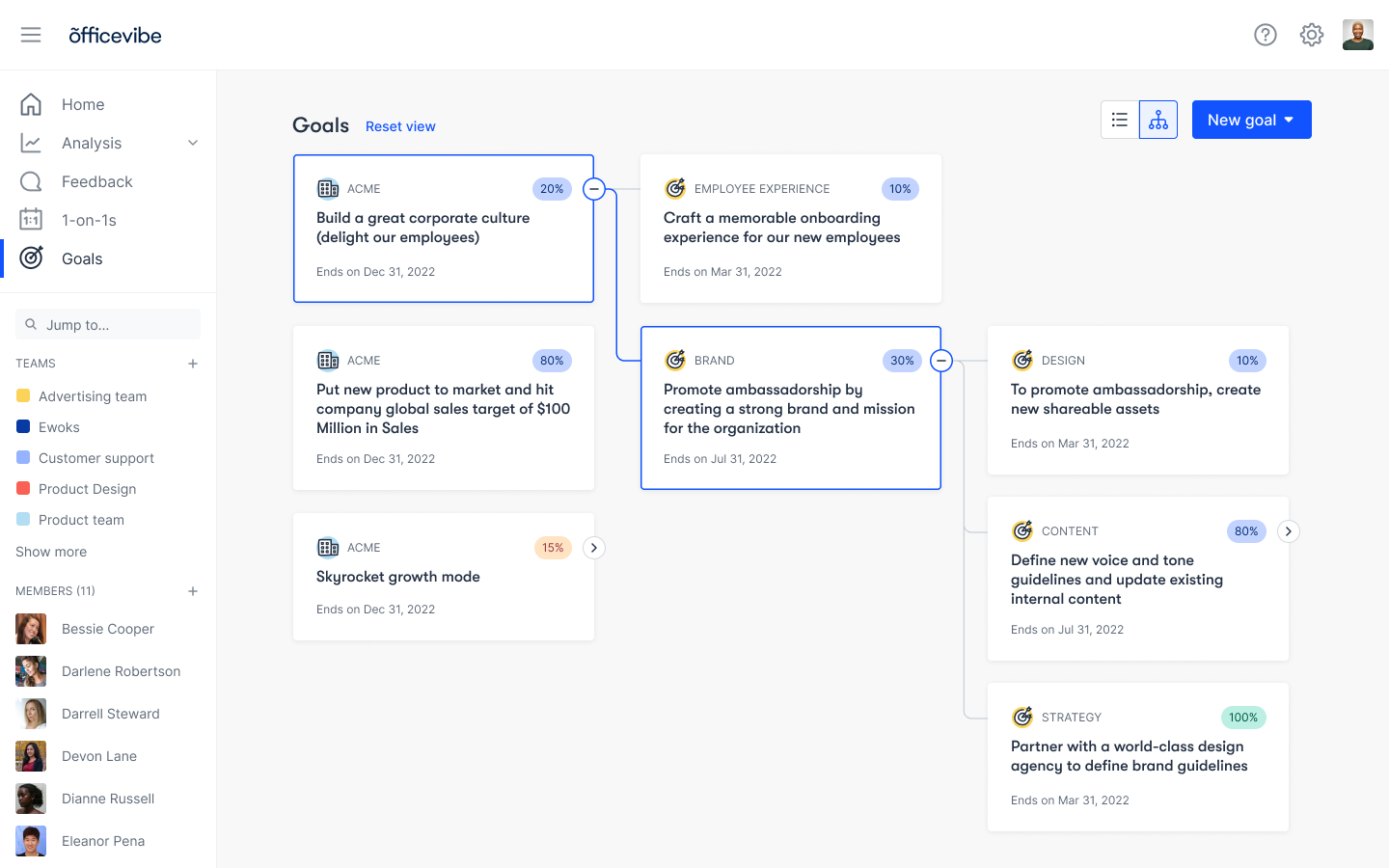Setting employee goals can be tough, even for the best managers. How do you make sure they stick? How do you give employees agency in their own development? And how do you make sure employees across your organization are on the same page? There's a lot to consider and it can feel overwhelming.
Luckily, there are great frameworks set in place to take the guesswork out for you and best practices to keep you on track. These goal-setting tips are sure to help you set meaningful, attainable employee goals for every member of your team.
Exclusive online summit
·
May 23 2024
Moments that matter: how to seed great work
What's in this article
Why is it important to set employee goals?
If you want to build an aligned team where everyone has a good understanding of where things are headed, and why those objectives are set in place, you need to add goal setting to your toolkit. It's what sets exceptional teams apart and ensures long-term individual and collective success.
Setting meaningful goals from the top down helps by:
- giving employees common objectives and helping everyone focus on what's important to the team and company.
- cutting through the clutter, reducing unnecessary stress, and enabling employees at all levels to achieve more in less time.
- bringing clarity to team members' individual roles and responsibilities, leading to higher job satisfaction.
- improving confidence, morale, and overall employee engagement for all when goals are achieved.
✨ Learn more about the foundations of goal setting with our guide to keeping your company aligned.
How to start your employee goal-setting journey
When it comes to setting goals, the first step is to choose a goal-setting framework to follow. While there are a few to choose from, OKRs are our new favorite at Officevibe. You'll soon see why.
What are OKRs and how do you set them?
OKRs stands for Objectives and Key Results. Objectives are the big-picture goals you want your team members to achieve by the end of the quarter or year. Key results are specific metrics that help you track whether they're meeting their objectives. It's important that these two things align with each other – otherwise, you may just be wasting time.
Employee goal-setting examples using the OKR framework
OKRs are written as follows: I will [objective] as measured by [key result].
Here's how they come to life in practical ways:
Example 1: I will improve our website user experience by the end of the year, as measured by a 15% increase in traffic, a 20% decrease in bounce rate, and a 30% increase in MQLs.
Example 2: I will improve our customer experience by the end of Q2, as measured by an increase in net promoter score from -5 to 30, a 20% increase in purchase rate, and a maintained customer acquisition cost under $15.
OKRs make it easy for employees to understand what's expected of them and how their work contributes to the company's goals. When everyone shares the same understanding of how their own goals and work relate to the company's mission, it's easier for everyone to feel invested in their role – which leads to happier employees who want to do great work.
Setting great OKRs with a goal-setting software
The goal-setting tool on Officevibe, designed with the OKR framework in mind, allows you to create organizational, team, and individual goals to propel your entire company forward with specific and measurable goals.

9 Tips for more effective goal setting
Once you’ve decided on your goal-setting process and you’re ready to sit down with your employee, follow these employee goal-setting tips to make the most of your meeting.
1. Make goal setting a collaborative effort
First and foremost, you want to set goals together with employees. People want a say in their own development, and your team members will be more committed to achieving their goals when they contribute to defining them. Schedule a one-on-one meeting with your employee to outline some professional goals, together.
Arrive prepared: Set some talking points in your meeting agenda, like discussing your team goals and company objectives. Ask your employee to reflect ahead about where they’d like to feel more challenged or what skills they’d like to develop more.
2. Tie goals back to your mission
If your employee’s goals are not aligned with your business’s strategic plan and overall mission, you may be misallocating resources or missing out on a huge opportunity. Engaged employees want to feel like they’re contributing to the success, growth, or evolution of the company. If they can tie their work directly to a global company outcome, they’ll feel valuable to the organization.
Outline broader KPIs: To create a culture that fosters goal setting, it's essential to have a clear vision of where the company is going and how each employee can contribute to that vision.
3. Set goals that are SMART
Smart goals are Specific, Measurable, Attainable, Relevant, and Time-based. Always keep this acronym in mind and check that the goals you set with employees fit. By doing this, employees will have concrete guidance and clarity on what's expected of them.
Double down: You can't go wrong with using the SMART framework in parallel with OKRs. You can do this by having employees write their objectives and key results, and cross-referencing them with a SMART checklist.
4. Look to examples for inspiration
If you’re not sure how to properly formulate an employee goal, try looking at some employee goal setting examples. Whether you’ve set lots of employee goals, never set employee goals, or haven’t set employee goals in a while, this is a good place to start. It will spark your inspiration and help you understand the key components that make up a well-structured goal.
Double down: You can't go wrong with using the SMART framework in parallel with OKRs. You can do this by having employees write their objectives and key results, and cross-referencing them with a SMART checklist.
5. Set goals that are attainable…
Ambitious goals can help push your employees to reach their full potential. But if it’s too ambitious to the point of being an unattainable goal, it can have the opposite effect. When employees get discouraged or start to question their abilities, it can really impact their motivation levels and morale. So don’t hesitate to scale a big goal back a little if necessary.
Scope it down: When you and your employee come up with an idea for a goal, try breaking it into smaller goals. Ask them how they could outline their goal in a timeline, or what steps they would take to achieve it.
6. …but keep a little challenge
On the other hand, you don’t want to set a goal that’s so easy that your employee doesn’t have to work for it. Employees should feel challenged by their goals, but in a way that’s exciting rather than overwhelming. It should be seen as an opportunity for growth, skills development, or career advancement. This is sometimes called a stretch goal.
Build it up: When you have a goal idea, try expanding it a little to make it bigger. Ask your employee how they could take it to the next level, what they would do next after achieving it, or what greater goal they could contribute to.
7. Play to each employee’s strengths
Everyone has different strengths, and the best goals are the goals that will build those strengths up. Whether it’s their technical skillset, area of personal interest, or natural abilities, try to incorporate employees’ strengths into their goals. At the end of the day, everyone’s personal ambitions, motivators, and work ethic are unique, so their goals should be, too.
For example: An employee with strong communication skills could have a networking goal. Or, an employee who enjoys learning could register for a course on a relevant topic to the industry or field.
8. Develop their weaknesses
Helping your employees overcome weaknesses through goal-setting can be just as empowering as further developing strengths. With the right structure, an objective that tackles something your employee is not so great at will not be daunting. A little improvement can also result in a whole lot of confidence.
Buddy system: People often learn best from other people. For a great learning opportunity, consider pairing teammates up that complement each other's strengths and weaknesses.
9. Set employees up for success
Employee goal setting is one part of the equation. But it’s not enough to just help your employees set goals, you also need to help them achieve those goals with an action plan. Make sure you’re giving your employees everything they need to hit their key result or objective. Whether that’s additional resources, training, new software or technology, a coach or mentor, or something else.
Define goal success: When you’re setting goals with an employee, ask them what they would need to achieve them. Determine together what it will take, and how you can get those things in place for them.
Now that your employee’s goals are set, what should you do next?
Once you’ve chosen your framework and have had your conversation using our nine tips, the rest will come easily. You just need a bit of maintenance to keep your engine running smoothly all year long. Here’s what we recommend:
- One-on-ones: Meet with your employees through regular one-on-one meetings for tracking progress on employee performance. Speaking about employee goals throughout the year also makes for seamless annual reviews when the time comes.
- Action items: Assign action items after your one-on-ones to establish clear commitments and help your employees move one step closer to their broader goals.
- Questions and blockers: Asking the right questions during your meetings will help you monitor your employee’s goal progress and unblock any obstacles that may be hindering their success.
- Feedback: Give both positive and constructive feedback regularly so employees know where they stand with respect to reaching their goals.
- Adapt and adjust: Sometimes team and organizational priorities shift or even change altogether. The beauty of great OKRs is that they’re flexible. When strategic business goals change, you can easily adjust your targets as needed.
You’re set for successful goal setting!
No matter what approach you take, these tips will help you with successful goal setting for every employee on your team. Use them to make every short-term goal and long-term goal achievable and motivating.



